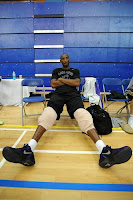This is a post about anti-inflammatories/pain killers and ice. You want to know which is better, then read on:
It’s not uncommon for patients coming into my Los Angeles chiropractic clinic to ask me whether they should use anti-inflammatories or not. First I start with the usual, “I’m not a medical doctor, so blah, blah, blah, blah…,” and then I say, “Let me explain the difference.”
An anti-inflammatory (Motrin, Advil) works by dispersing throughout your body–you ingest it, it goes into your bloodstream, and is carried to every nook and cranny of your body indiscriminately. What this means is that some goes here, some goes there, but overall it does the trick for reducing some types or degrees of inflammation.
 Ice, on the other hand, is like a blast of cold–cryotherapy it’s called–going right to the source.
Ice, on the other hand, is like a blast of cold–cryotherapy it’s called–going right to the source.
Anti-inflammatories are good for:
- fever
- tooth aches
- um…um…um………can’t really think of anything else
Ice is outstanding for many musculoskeletal inflammations including:
- acute injuries
- tendonitis
- bursitis
- impingement syndromes
- tears
- sprained ankles

And the list could go on, but you get the point.
I cracked a tooth in 2008 and don’t know what I would have done without Motrin (couldn’t rightly ice my tooth). And I had the flu last Christmas–once again, Tylenol was a savior.
So what’s better? Well it depends. But for musculoskeletal injuries and inflammations…my money’s on ice.











